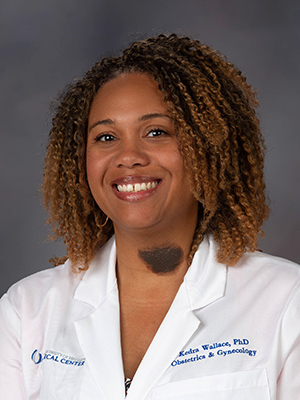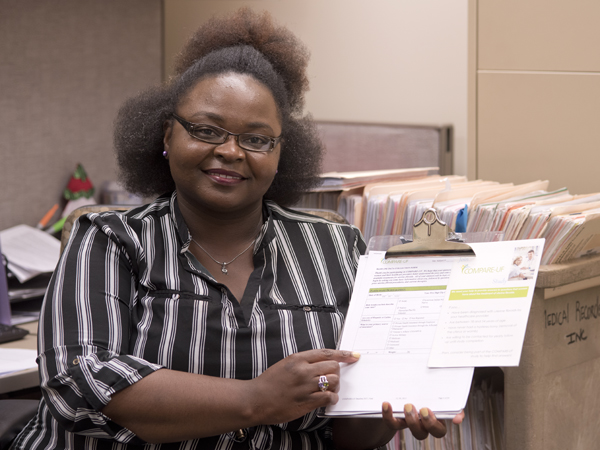COMPAREing stories, conquering fibroids

Published in News Stories on May 16, 2016
Women diagnosed with uterine fibroids have questions. How did other women manage their condition? What treatment will work best for me? A new clinical registry at UMMC and across the country may answer these questions and help women compare their options.

“We are excited to be a part of COMPARE-UF,” said Dr. Kedra Wallace, assistant professor of obstetrics and gynecology. She is the local investigator for Comparing Options for Management: Patient-centered Results for Uterine Fibroids, a national registry designed to help patients and physicians learn which therapies are most effective against fibroids.
Unlike clinical trials, registry participants choose their own treatment and researchers track their progress. It's all about the patients, Wallace says.
“The primary goal of the registry is to hear everyone's story. We want to understand how a woman's quality of life changes after her chosen treatment for uterine fibroids,” Wallace said.
Uterine fibroids are muscle cell clusters that grow on, in or connected to the uterus. About 75 percent of women develop fibroids but only 30 percent have symptoms such as heavy menstrual bleeding, pelvic pain and infertility.

“A woman's concerns depend on the category of her symptoms,” said Dr. Preston Parry, associate professor of obstetrics and gynecology. “If she has pressure symptoms, then she wants relief. If she's bleeding, then she wants to not feel tired or anemic anymore.”
Treatments including hysterectomy (removal of the uterus) and myomectomy (removal of the fibroids) may provide relief for women with severe symptoms. For women who want to become pregnant this raises another question, Parry says.
“How can I address this without being sterilized?”
In addition, no two women or cases are exactly alike, which may make choosing the best option difficult.
“The number, size and location of fibroids is very different from one woman to another,” Parry said. “It's like comparing apples to oranges. The symptoms caused by one small fibroid don't compare to those caused by 60 fibroids.”
By collecting information from 10,000 women nationwide, COMPARE-UF will determine which treatments may be best for varying symptoms and types of fibroids.Women who participate answer a series of questions about symptom relief and effectiveness after receiving their chosen fibroid treatment, followed by three annual interviews post-treatment.
Sherrina Dixon, an LPN clinical research specialist, works with potential participants at UMMC to tell them about the registry and answer their questions. Her personal experience with uterine fibroids helps her relate to patients.

Dixon
Dixon learned she had fibroids during a doctor's visit in 2010. The serious pain started two years later.
“I couldn't even get out of bed some mornings,” Dixon said. “The back pain, nausea and vomiting were terrible.”
She used pain medication to manage her symptoms, rather than an invasive surgery. However, in June 2015 during one of Dixon's shifts on 4 North the pain became too much.
“The next day I saw my physician and that's when we decided I would have a hysterectomy,” Dixon said. Since the surgery, the pain is gone and the difference is like night and day.
“I felt like I regained myself back and had a new lease on life,” Dixon said. “Chronic pain impacts your life not just physically but also mentally.
“The women I've talked to so far have been anxious and cautious, but I tell them, 'I know what you're experiencing because I went through this, then my doctor and I decided to do this,'” Dixon said.
UMMC has two women enrolled in the registry so far, Dixon says.
“(Dixon) can also reach out to other clinics in the Jackson area to recruit participants,” Wallace said, which will help the team reach their goal of 2,000 local women enrolled in the registry.
Wallace says UMMC is a valuable location within COMPARE-UF's nine-center national network. African-American women are two to three times more likely to have uterine fibroids than other women, so a study site in Jackson may help patients and researchers understand the particular concerns and responses of African-American women regarding their health.
“In Mississippi, we see fibroids that are more pronounced than much of the rest of the country,” Parry said. “Participating in this registry can extend our understanding of uterine fibroid development and treatment.”
The study is currently in Phase I, which is only open to women with uterine fibroids who are pursuing surgical treatments such as hysterectomy, myomectomy or other techniques such as those undergoing clinical trials at UMMC and other medical centers.
“Ultimately, how a woman treats uterine fibroids is for her and her doctor to decide,” Dixon said.

Additional information
The Patient-Centered Outcomes Research Institute (PCORI) funds COMPARE-UF. The Duke Clinical Research Institute serves as the primary registry coordinator.
For more information about COMPARE-UF, click here.


